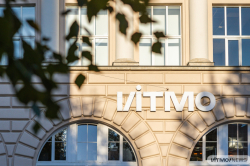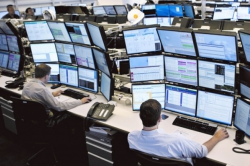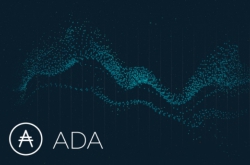How did the Pallium project begin?
I first heard the word "blockchain" sometime in 2016 and became interested in this topic. I read about it on Wikipedia, bought the Melanie Swan book "Blockchain: Blueprint for a New Economy” and was surprised how global this technology is. At some point, my friend and I decided, as did many in the industry, to get into mining. This was the initial step, during which we raised outside funds and invested our own. Things like ICOs and tokens emerged at that time - in a word, a new economy was rising, and we wanted to be part of it. Our first project had to do with trading and was our first push towards Pallium. Back then we still knew very little about artificial intelligence and its capabilities, but what we had was a clear idea. Next, we studied the new field for a year, communicated with specialists, followed the news, and it all had grown into the project that we are working on today.

There are currently eight members in your team. Tell us about them.
I have known Alexei Sukhov, the company's CEO, for 10 years. We are both from the city of Yaroslavl. When we began developing the project, I had lived in St. Petersburg for two years. We had an unpleasant incident at the beginning: our first investor panicked after a sharp cryptocurrency decline and withdrew all the funds. We did not have any contracts finalized at the time, and we were literally on the verge of selling everything that we had. When we were leaving the office, we ran into the landlord ,who invested money into our project, which allowed us to save it. We hired the rest of the team, who are responsible for PR and marketing, after a long and tiring search. Among them, for example, is Fadi Albouni, responsible for working with our English-speaking partners. We also have a talented programmer from Innopolis Mikhail Lubinets, who is now completing his studies.

You have recently won a Japanese pitch-session and then you went to the Minsk Blockchain & Bitcoin Conference, where your project took the first place. Now you are competing for a prize 120 thousand dollars. Tell us about this experience.
We took the first place at the conference "Japan - Country of the Rising Sun" and got the opportunity to go there to present the project on a new market. It was a surprise for us. Usually we present the project for investors and look for advisers who can help us in such areas as blockchain, artificial intelligence, law, distributed computing systems, programming languages design, big data and so on. We also participated in a conference in Minsk, where we took the first place. This victory was an opportunity to compete for 120 thousand dollars from the Pulsar Venture Capital fund that raised $15 million with its ICO. Now the fund is looking for startups all over Russia and the best will receive financial support and development opportunities. We will compete for this prize in Kazan this April.
In addition, last Saturday the Global Blockchain Summit conference took place in Sochi, where we competed for the opportunity to go on a road-show through China. A trip to China is especially important for startups: it is believed that if you find Chinese investors, then your success is guaranteed. Participation in such conferences gives you great opportunities to find new professional connections, let the whole world know about your project and attract funds that are not just venture capital (ICO is a collection of funds from a large number of people, who are interested in a product). Sometimes it takes only minutes to raise millions of dollars there. Therefore, it is important for us to present ourselves at such events.

And what is the project about?
We are making a decentralized network (one that does not belong to one organisation, but belongs to all of the participants): anyone can participate, support the network and make money off it. This network is an environment in which machine algorithms can interact with each other and with the surrounding world (that is, with people) completely autonomously, where they can learn and work, transfer cryptocurrency and knowledge. One peculiarity of the system is that it is built on agents. According to the FIPA (Federation of Intelligent Physical Agents), an agent is an entity that receives data on the events occurring in its environment, interprets them and executes commands that affect said environment. If we consider a person as an agent, then we perceive the surrounding world through the senses, interpret it and act on it with parts of the body. A software agent is a program that accepts some incoming data, processes it and passes the result back. An agent that has an internal decision-making system is an intelligent agent. A person has this system: the environment affects you, then you decide how to react to the situation, and bring this decision into action. A scoring system that analyses your financial situation and through the internal system, approves or disapproves of your loan, can also be called an intellectual one. In fact, practically everything that we interact with in everyday life can be put into the concept of "intellectual agents".

Have you seen an agent-oriented approach somewhere else?
We’re familiar with such ideology,but we have not seen it implemented. There is a problem that many experts are not yet aware of, and that is the fact that artificial intelligence has entered the mass consciousness: the media is full of headlines of new achievements of machines in almost all aspects of human life. Thus, AI defeats pros in games, diagnoses illnesses better than doctors, analyses financial markets, drives cars, creates poetry and music, recommends us where to go, what to see and what to buy. Advances in artificial intelligence push organisations and states to invest significant resources into the industry, moving the market forward. The question of trust is raised. Can we trust the AI so much as to delegate an important part of our life to it?
The problem is that we do not see the algorithms by which the agent makes its decisions. So there is a possibility that the agent can be biased, and this bias can be either intentionally built-in, or not. Mathematician and analyst Cathy O'Neil in her book "The Weapon of Math Destruction" convincingly proves that algorithms always have a hidden bias and reflect the ideology of the ones who created them. The simplest example is an algorithm that hires a person, that is, a program used to interview the candidate instead of a person, and suddenly a person is refused without grounds. In other words, they were discriminated against, the question is – why? What are the criteria for the machine? It is impossible to understand how it happened in closed systems.

In turn, if we consider the blockchain an environment for such intellectual agents, then the inherent technological principle of transparency can somehow level this problem. We can always check what is inside the agent, trace the history of the changes, make sure that the agent acts according to its present state and does not do otherwise. Globally speaking, it is a system of trust in an environment where no one trusts anyone, like a regulator.
The project’s website states that your platform can be useful to different kinds of users, for example, developers of artificial intelligence. How exactly?
If you develop algorithms (in this case, agents), you create the agent yourself and write a smart contract for it. A smart contract controls how the agent interacts with its environment, as well as how it changes its internal decision-making system. This way if the incoming data structure is specified in the contract, the agent will not be trained on another data structure, its decision algorithm will not change unexpectedly, and the range of impact on the environment will remain unchanged. The developer uploads the agent to the network, where the agent can immediately learn from the participants’ computing resources. It saves money, as not everyone has global tasks - sometimes they just need to launch something or test it. Our platform allows you to do all of this and save the results in a decentralised network.
For example, let's imagine an interaction of two agents outside the blockchain. There is Agent A, which exists somewhere on the server of its creator. Suppose this agent predicts a bitcoin fluctuation and signals about buying or selling. On the other server, we have Agent B. Based on a signal from Agent A, Agent B makes a transaction on the exchange and pays Agent A for these signals. These agents work completely autonomously. There are threats in this interaction. The creator of agent A, without notifying anyone, may change its state, change the decision algorithm, or even make it predict the Ethereum fluctuation. Due to these changes, Agent B will receive an incorrect signal, and its owner will lose money. In turn, Agent B may not pay agent A for signals. Of course, creators of the agents can negotiate the conditions, make a contract, but we are talking about fully autonomous work without any intervention by third parties in an environment where participants are often anonymous.

Using the potential of blockchain and smart contracts, we can draw up a smart contract between these agents and bring to naught any conflict situations. All this opens up the possibility of transferring values between agents in the form of tokens. Agents can learn from each other, become more advanced and work offline.
How can miners use the network?
Miners are the people who support the blockchain system. Miners are actually engaged in confirming the block in the blockchain. Today we see a tendency of transition of cryptocurrency from the Proof-of-Work (PoW) consensus algorithm to the Proof-of-Stake (PoS). This means that you no longer need massive computing resources to prove your right to make entries into the blockchain. Accordingly, now the computing resources for $60 billion are concentrated in the hands of the miners (both large data centers and simply private laptops). On average, last year miners earned two dollars per day from one graphic card; if, however, a card was given for AI to train on in accordance with the Amazon cloud service, the miner would receive $2 per hour. That is, to process artificial intelligence is much more profitable than to mine. The main cryptocurrency today is Ethereum. If it switches to Proof-of-Stake, the miners will be out of work, and it will be necessary to find a use for the power concentrated in their hands. When the benefit of mining is lost, it is impossible to sell these graphic cards. Right now they are easy to sell, because they are in demand, but then they will not be needed. That is when our network will come handy. Miners can connect to us, their equipment will be used to train AI and the AI creators will reward the miners. We create an environment where people can interact directly without intermediaries, as even we cannot influence the network or change anything in it without coordinating the changes with all members of the network.

Why do you need a network of data providers and organisations?
To be able to train themselves, the agents need data, and they need a lot of it. On the one hand, there is a problem of the lack of data. On the other hand, there are organisations that have this data. Suppose a certain factory has collected the characteristics of metals throughout 1979. It has this data stored, but they are not involved. So there are people who could benefit from this data, and simultaneously there is unused data Our system enables these market participants to communicate and sell the data.
Organisations, in turn, can purchase agent data. Suppose that Alice wrote a cool agent that makes credit scoring. A bank that needs such an algorithm finds the agent, pays for its work, uploads the data and the agent solves the problem. Alice gets the money and the bank gets a loan decision.

At what stage is the project now?
Now we have MVP, in which the agent considers the factorial of the number, but does it through a smart contract on our virtual machine and in the prototype of the future distributed computer network. The alpha version is planned for release in four months; it will be a test network completely under our control, that is, it will not be a mass testing. We are now negotiating with companies that are interested in testing this technology in private. We want to launch a production release in a year. The entire road map is on our website. We will go to pre-ICO in April, when we plan to collect 500 thousand dollars to create a product you can actually “get your hands on”.
How do you plan to earn money on the project?
By possessing the tokens, we have our own team’s pool of tokens of two kinds. One is PLMT tokens to raise funds; they are released on the Ethereum blockchain platform. Another currency - SPIKE - regulates the relationship between the platform participants. Tokens can be bought on the exchange, and all operations will be conducted with their help. This removes a lot of middlemen, reduces prices tens of times for the end user and creates a kind of internal economy. It acts as a motivation for people, supports the project and the life of the network.
We also use our computer center to mine and earn the same way as every member of the network. So far the question remains as to what percentage will be taken from each transaction. If we implement any, it will be minimal, only to support our staff.

Russian law does not regulate your area of work. At the same time, the Pallium website says that the company is registered under the jurisdiction of Estonia. What is the reason for this decision?
Russian law does not regulate this area in any way, which creates certain difficulties, because you do not know what to expect. We would gladly register everything here, because there are companies that conduct ICO in Russia, but we do it under the European jurisdiction, because this is a more secure way. The thing is, right now many don’t understand what cryptocurrency is and how it can be regulated. Let's say I'm an investor and I want to buy tokens from you, since you offer them. I can buy them, but I do not make accounting entries for the assets I bought. For example, if a company buys shares, it can indicate that it has purchased five shares for 100 roubles, and the company becomes the owner of these shares. You cannot do this with tokens, because there is no definition for them in Russian law. The situation is somewhat different in Europe. For example, in Germany, cryptocurrency is recognized as a legal means of payment, and in Estonia we can simply bind the cryptocurrency account to our organization, put it on balance, and tokens will be considered our digital assets. In Russia, too, they talk about legalising cryptocurrency, so we’ll see what happens next.
You are a member of Future Technologies, but Pallium is far from a usual startup for an acceleration program. Methods that work with other startups may not work for you. What is the main problem?
It's true. I will start, perhaps, with the benefits, which are: constant evaluation of us and the level of preparation from the outside. Still, we often participate in conferences, and it is important to know what stage we are on, although it is difficult for the public to accept the idea and the product. That was our main obstacle. Countless times did we have to defend our idea to change people's minds. Say, we require a financial model, but we cannot describe it, because the network does not belong to us. Thus, ordinary methods do not suit us. They do not suit anyone who works with decentralized systems. You need to work differently with such projects, but only the community produces the necessary tools.
Translated by Pavel Vorobyev




